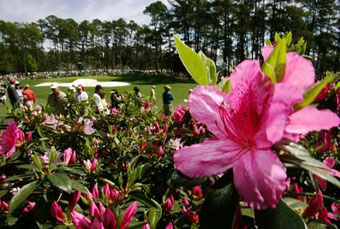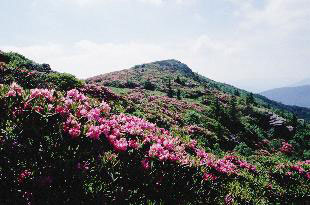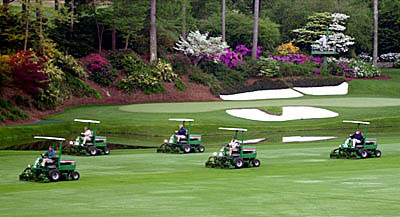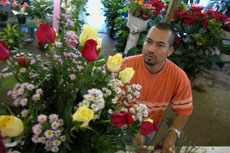Human Flower Project
Azaleas—‘Say Amen’
The Masters golf tournament begins today, graced by Mother Nature and two Belgian nurserymen.

On #6, during practice for the Masters
Photo: David J. Phillip, for AP
We are golf-averse. The clothes, the manners, the country clubs, that smug little humming sound the carts make all elicit our inner gangster. Golf has even made us hate azaleas.
Today The Masters, the most azaleafied event on the globe, begins in Augusta, Georgia. Everything at the Masters is “traditional”: the winner’s green jacket, “The Eisenhower Tree,” and the 6 zillion azalea bushes blooming to order.
Hole # 13 is even called “Azalea.” Mounds of the tournament’s “signature shrub” line the left side of this hole “from tee to green.” Actually, all the holes at Augusta are named for some tree or plant, but somehow it’s these garish piles of pink and white sloping down to the immaculate fairways that, to us, scream “ELITISM!”
How does the Masters get its flowers to perform each April? We learned today that the Augusta National course had a big head start: it used to be a nursery. Before golfers bought the property, in 1931, it was Fruitland Nursery owned by a father and son team of Belgian horticulturists, the Berckmans. From 1858 to 1918, they introduced scores of plants, shrubs, and trees to gardens and orchards of the Southeast. Prosper Berckmans “developed or improved many types of peaches and eventually became known as the ‘Father of Peach Culture’ across the South.”
It was Prosper also who popularized the native azaleas, spreading them to domestic landscapes—and ultimately, golf courses, too—through his nursery business. This species of the rhododendron family grows abundantly in the Appalachian Mountains.
The Masters (like all elites) would have one believe that the appearance of the course is natural. “‘At Augusta National Golf Club, we are concerned about the environment,’ said Hootie Johnson, club chairman. ‘A state-of-the-art irrigation system and a primarily curative versus preventative philosophy are just two examples of our commitment to the environment.’” What does THAT mean?
 In the Roan Highlands, 2001
In the Roan Highlands, 2001
Photo: Donald W. Hyatt
If you really want to see azaleas in nature, check out this glorious site assembled by azalea expert Donald W. Hyatt, with a photographic guide to the pinks, whites and peachy-oranges of the region. His shots of azaleas growing along Roan Mountain offer an antidote to Augusta’s ungodly greens. See too Hyatt’s essay on the azalea’s history in the region; all the invented traditions of the Masters look like flashes in the pan.
For this year’s tournament the manicured vistas, we learn, have been elongated, to accommodate Tiger’s and John Daly’s long drives; otherwise, surely, all will be the same. No women allowed to join the Augusta National Golf Club. And that’s a.o.k. We’ll take our stand and our $40,000 membership fee elsewhere.

Mowers prepare Augusta National for the Masters
Photo: BBC
Enough grumping. After learning about the Berckmans and seeing Don Hyatt’s site, we just may check in on Amen Corner, the 11th, 12th, and 13th (Azalea) holes that seem to make or break the tournament. You can watch it on your flat screen TV or on your computer screen. This year the Masters will be showing “Amen Corner Live!” online, as each player treads the fairways fantastic. Play started at 10:30 today and will go on through suppertime Sunday.

